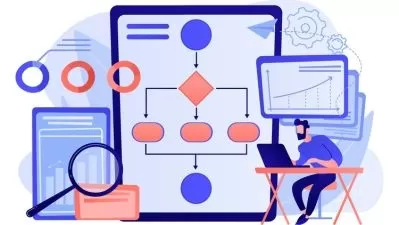The Complete Visual Guide to Machine Learning & Data Science
Maven Analytics,Chris Dutton,Joshua MacCarty
8:47:24
Description
Explore Data Science & Machine Learning topics with simple, step-by-step demos and user-friendly Excel models (NO code!)
What You'll Learn?
- Build foundational machine learning & data science skills WITHOUT writing complex code
- Play with interactive, user-friendly Excel models to learn how machine learning techniques actually work
- Enrich datasets using feature engineering techniques like one-hot encoding, scaling and discretization
- Predict categorical outcomes using classification models like K-nearest neighbors, naïve bayes, and decision trees
- Build accurate forecasts and projections using linear and non-linear regression models
- Apply powerful techniques for clustering, association mining, outlier detection, and dimensionality reduction
- Learn how to select and tune models to optimize performance, reduce bias, and minimize drift
- Explore unique, hands-on case studies to simulate how machine learning can be applied to real-world cases
Who is this for?
More details
DescriptionThis course is for everyday people looking for an intuitive, beginner-friendly introduction to the world of machine learning and data science.
Build confidence with guided, step-by-step demos, and learn foundational skills from the ground up. Instead of memorizing complex math or learning a new coding language, we'll break down and explore machine learning techniques to help you understand exactly how and why they work.
Follow along with simple, visual examples and interact with user-friendly, Excel-based models to learn topics like linear and logistic regression, decision trees, KNN, naïve bayes, hierarchical clustering, sentiment analysis, and more – without writing a SINGLE LINE of code.
This course combines 4 best-selling courses from Maven Analytics into a single masterclass:
PART 1: Univariate &Â Multivariate Profiling
PART 2: Classification Modeling
PART 3: Regression & Forecasting
PART 4: Unsupervised Learning
PARTÂ 1:Â Univariate &Â Multivariate Profiling
In Part 1 we’ll introduce the machine learning workflow and common techniques for cleaning and preparing raw data for analysis. We’ll explore univariate analysis with frequency tables, histograms, kernel densities, and profiling metrics, then dive into multivariate profiling tools like heat maps, violin & box plots, scatter plots, and correlation:
Section 1: Machine Learning Intro & Landscape
Machine learning process, definition, and landscape
Section 2: Preliminary Data QA
Variable types, empty values, range & count calculations, left/right censoring, etc.
Section 3: Univariate Profiling
Histograms, frequency tables, mean, median, mode, variance, skewness, etc.
Section 4: Multivariate Profiling
Violin & box plots, kernel densities, heat maps, correlation, etc.
Throughout the course, we’ll introduce real-world scenarios to solidify key concepts and simulate actual data science and business intelligence cases. You’ll use profiling metrics to clean up product inventory data for a local grocery, explore Olympic athlete demographics with histograms and kernel densities, visualize traffic accident frequency with heat maps, and more.
PARTÂ 2:Â Classification Modeling
In Part 2 we’ll introduce the supervised learning landscape, review the classification workflow, and address key topics like dependent vs. independent variables, feature engineering, data splitting and overfitting. From there we'll review common classification models like K-Nearest Neighbors (KNN), Naïve Bayes, Decision Trees, Random Forests, Logistic Regression and Sentiment Analysis, and share tips for model scoring, selection, and optimization:
Section 1:Â Intro to Classification
Supervised learning &Â classification workflow, feature engineering, splitting, overfitting &Â underfitting
Section 2:Â Classification Models
K-nearest neighbors, naïve bayes, decision trees, random forests, logistic regression, sentiment analysis
Section 3:Â Model Selection & Tuning
Hyperparameter tuning, imbalanced classes, confusion matrices, accuracy, precision &Â recall, model drift
You’ll help build a simple recommendation engine for Spotify, analyze customer purchase behavior for a retail shop, predict subscriptions for an online travel company, extract sentiment from a sample of book reviews, and more.
PARTÂ 3:Â Regression &Â Forecasting
In Part 3 we’ll introduce core building blocks like linear relationships and least squared error, and practice applying them to univariate, multivariate, and non-linear regression models. We'll review diagnostic metrics like R-squared, mean error, F-significance, and P-Values, then use time-series forecasting techniques to identify seasonality, predict nonlinear trends, and measure the impact of key business decisions using intervention analysis:
Section 1:Â Intro to Regression
Supervised learning landscape, regression vs. classification, prediction vs. root-cause analysis
Section 2:Â Regression Modeling 101
Linear relationships, least squared error, univariate & multivariate regression, nonlinear transformation
Section 3:Â Model Diagnostics
R-squared, mean error, null hypothesis, F-significance, T &Â P-values, homoskedasticity, multicollinearity
Section 4:Â Time-Series Forecasting
Seasonality, auto correlation, linear trending, non-linear models, intervention analysis
You’ll see how regression analysis can be used to estimate property prices, forecast seasonal trends, predict sales for a new product launch, and even measure the business impact of a new website design.
PARTÂ 4:Â Unsupervised Learning
In Part 4 we’ll explore the differences between supervised and unsupervised machine learning and introduce several common unsupervised techniques, including cluster analysis, association mining, outlier detection and dimensionality reduction. We'll break down each model in simple terms and help you build an intuition for how they work, from K-means and apriori to outlier detection, principal component analysis, and more:
Section 1:Â Intro to Unsupervised Machine Learning
Unsupervised learning landscape &Â workflow, common unsupervised techniques, feature engineering
Section 2:Â Clustering &Â Segmentation
Clustering basics, K-means, elbow plots, hierarchical clustering, dendograms
Section 3:Â Association Mining
Association mining basics, apriori, basket analysis, minimum support thresholds, markov chains
Section 4:Â Outlier Detection
Outlier detection basics, cross-sectional outliers, nearest neighbors, time-series outliers, residual distribution
Section 5:Â Dimensionality Reduction
Dimensionality reduction basics, principle component analysis (PCA), scree plots, advanced techniques
You'll see how K-means can help identify customer segments, how apriori can be used for basket analysis and recommendation engines, and how outlier detection can spot anomalies in cross-sectional or time-series datasets.
__________
Ready to dive in? Join today and get immediate, LIFETIME access to the following:
9+ hours of on-demand video
ML Foundations ebook (350+ pages)
Downloadable Excel project files
Expert Q&A forum
30-day money-back guarantee
If you're an analyst or aspiring data professional looking to build the foundation for a successful career in machine learning or data science, you've come to the right place.
Happy learning!
-Josh & Chris
Who this course is for:
- Anyone looking to learn the foundations of machine learning through interactive, beginner-friendly demos
- Data Analysts or BI experts looking to transition into data science or build a fundamental understanding of machine learning
- R or Python users seeking a deeper understanding of the models and algorithms behind their code
- Excel users who want to learn and apply powerful tools for predictive analytics
This course is for everyday people looking for an intuitive, beginner-friendly introduction to the world of machine learning and data science.
Build confidence with guided, step-by-step demos, and learn foundational skills from the ground up. Instead of memorizing complex math or learning a new coding language, we'll break down and explore machine learning techniques to help you understand exactly how and why they work.
Follow along with simple, visual examples and interact with user-friendly, Excel-based models to learn topics like linear and logistic regression, decision trees, KNN, naïve bayes, hierarchical clustering, sentiment analysis, and more – without writing a SINGLE LINE of code.
This course combines 4 best-selling courses from Maven Analytics into a single masterclass:
PART 1: Univariate &Â Multivariate Profiling
PART 2: Classification Modeling
PART 3: Regression & Forecasting
PART 4: Unsupervised Learning
PARTÂ 1:Â Univariate &Â Multivariate Profiling
In Part 1 we’ll introduce the machine learning workflow and common techniques for cleaning and preparing raw data for analysis. We’ll explore univariate analysis with frequency tables, histograms, kernel densities, and profiling metrics, then dive into multivariate profiling tools like heat maps, violin & box plots, scatter plots, and correlation:
Section 1: Machine Learning Intro & Landscape
Machine learning process, definition, and landscape
Section 2: Preliminary Data QA
Variable types, empty values, range & count calculations, left/right censoring, etc.
Section 3: Univariate Profiling
Histograms, frequency tables, mean, median, mode, variance, skewness, etc.
Section 4: Multivariate Profiling
Violin & box plots, kernel densities, heat maps, correlation, etc.
Throughout the course, we’ll introduce real-world scenarios to solidify key concepts and simulate actual data science and business intelligence cases. You’ll use profiling metrics to clean up product inventory data for a local grocery, explore Olympic athlete demographics with histograms and kernel densities, visualize traffic accident frequency with heat maps, and more.
PARTÂ 2:Â Classification Modeling
In Part 2 we’ll introduce the supervised learning landscape, review the classification workflow, and address key topics like dependent vs. independent variables, feature engineering, data splitting and overfitting. From there we'll review common classification models like K-Nearest Neighbors (KNN), Naïve Bayes, Decision Trees, Random Forests, Logistic Regression and Sentiment Analysis, and share tips for model scoring, selection, and optimization:
Section 1:Â Intro to Classification
Supervised learning &Â classification workflow, feature engineering, splitting, overfitting &Â underfitting
Section 2:Â Classification Models
K-nearest neighbors, naïve bayes, decision trees, random forests, logistic regression, sentiment analysis
Section 3:Â Model Selection & Tuning
Hyperparameter tuning, imbalanced classes, confusion matrices, accuracy, precision &Â recall, model drift
You’ll help build a simple recommendation engine for Spotify, analyze customer purchase behavior for a retail shop, predict subscriptions for an online travel company, extract sentiment from a sample of book reviews, and more.
PARTÂ 3:Â Regression &Â Forecasting
In Part 3 we’ll introduce core building blocks like linear relationships and least squared error, and practice applying them to univariate, multivariate, and non-linear regression models. We'll review diagnostic metrics like R-squared, mean error, F-significance, and P-Values, then use time-series forecasting techniques to identify seasonality, predict nonlinear trends, and measure the impact of key business decisions using intervention analysis:
Section 1:Â Intro to Regression
Supervised learning landscape, regression vs. classification, prediction vs. root-cause analysis
Section 2:Â Regression Modeling 101
Linear relationships, least squared error, univariate & multivariate regression, nonlinear transformation
Section 3:Â Model Diagnostics
R-squared, mean error, null hypothesis, F-significance, T &Â P-values, homoskedasticity, multicollinearity
Section 4:Â Time-Series Forecasting
Seasonality, auto correlation, linear trending, non-linear models, intervention analysis
You’ll see how regression analysis can be used to estimate property prices, forecast seasonal trends, predict sales for a new product launch, and even measure the business impact of a new website design.
PARTÂ 4:Â Unsupervised Learning
In Part 4 we’ll explore the differences between supervised and unsupervised machine learning and introduce several common unsupervised techniques, including cluster analysis, association mining, outlier detection and dimensionality reduction. We'll break down each model in simple terms and help you build an intuition for how they work, from K-means and apriori to outlier detection, principal component analysis, and more:
Section 1:Â Intro to Unsupervised Machine Learning
Unsupervised learning landscape &Â workflow, common unsupervised techniques, feature engineering
Section 2:Â Clustering &Â Segmentation
Clustering basics, K-means, elbow plots, hierarchical clustering, dendograms
Section 3:Â Association Mining
Association mining basics, apriori, basket analysis, minimum support thresholds, markov chains
Section 4:Â Outlier Detection
Outlier detection basics, cross-sectional outliers, nearest neighbors, time-series outliers, residual distribution
Section 5:Â Dimensionality Reduction
Dimensionality reduction basics, principle component analysis (PCA), scree plots, advanced techniques
You'll see how K-means can help identify customer segments, how apriori can be used for basket analysis and recommendation engines, and how outlier detection can spot anomalies in cross-sectional or time-series datasets.
__________
Ready to dive in? Join today and get immediate, LIFETIME access to the following:
9+ hours of on-demand video
ML Foundations ebook (350+ pages)
Downloadable Excel project files
Expert Q&A forum
30-day money-back guarantee
If you're an analyst or aspiring data professional looking to build the foundation for a successful career in machine learning or data science, you've come to the right place.
Happy learning!
-Josh & Chris
Who this course is for:
- Anyone looking to learn the foundations of machine learning through interactive, beginner-friendly demos
- Data Analysts or BI experts looking to transition into data science or build a fundamental understanding of machine learning
- R or Python users seeking a deeper understanding of the models and algorithms behind their code
- Excel users who want to learn and apply powerful tools for predictive analytics
User Reviews
Rating
Maven Analytics
Instructor's CoursesChris Dutton
Instructor's CoursesJoshua MacCarty
Instructor's Courses
Udemy
View courses Udemy- language english
- Training sessions 179
- duration 8:47:24
- Release Date 2023/05/18











![Supervised Machine Learning Complete Masterclass [2023]](https://traininghub.ir/image/course_pic/9453-x225.webp)




